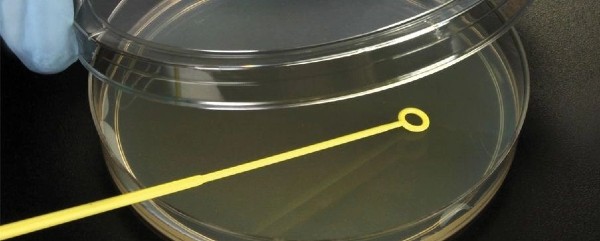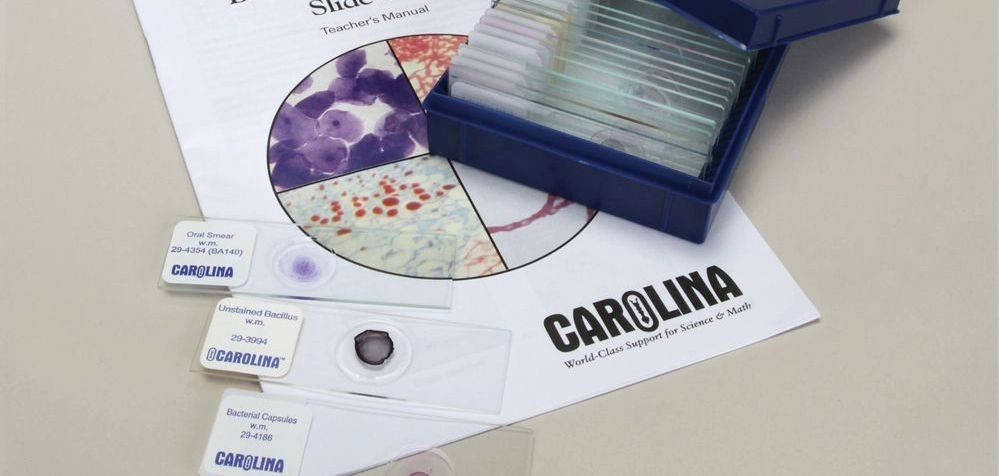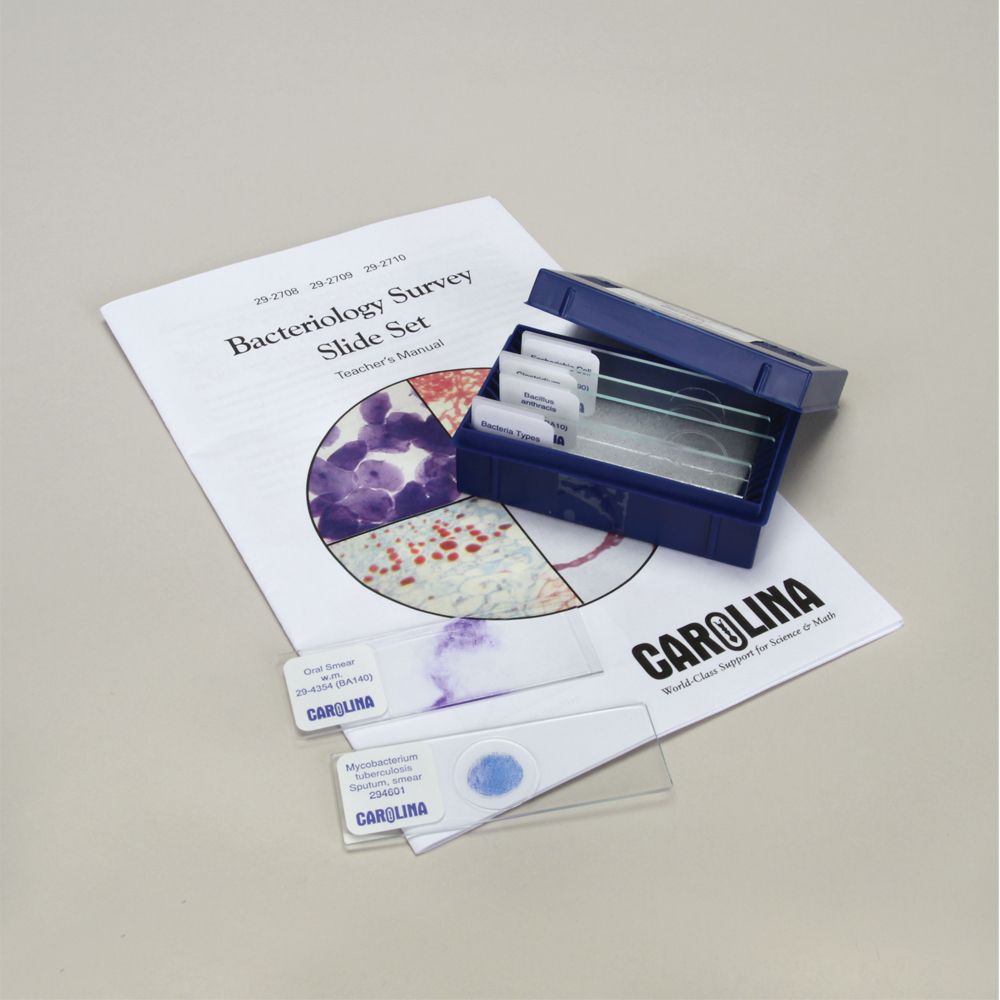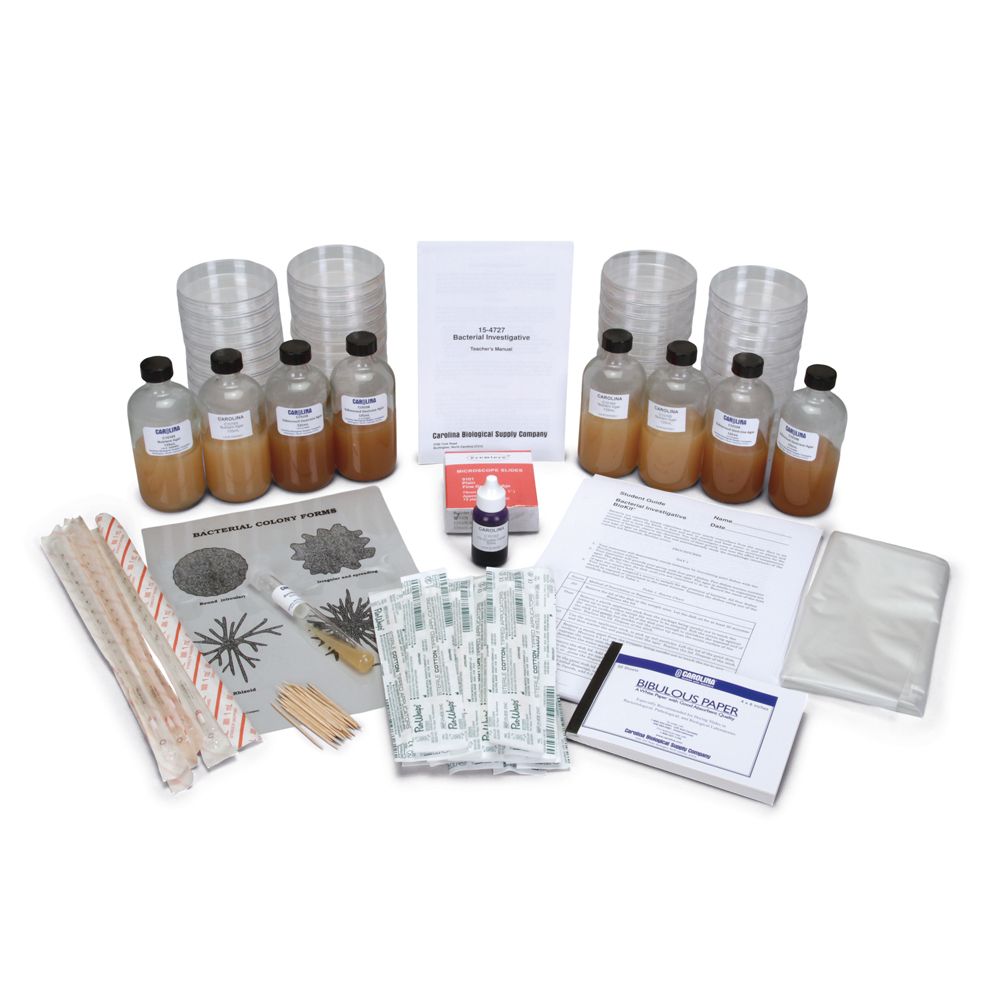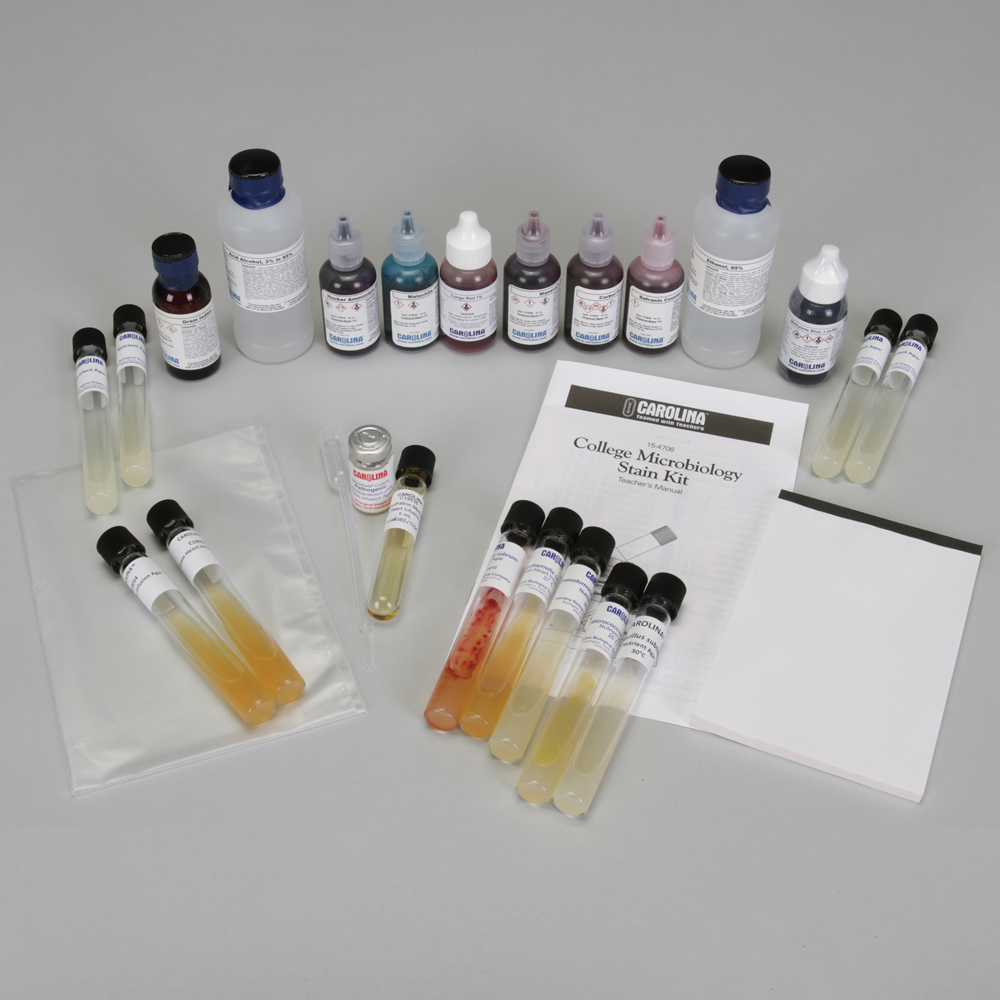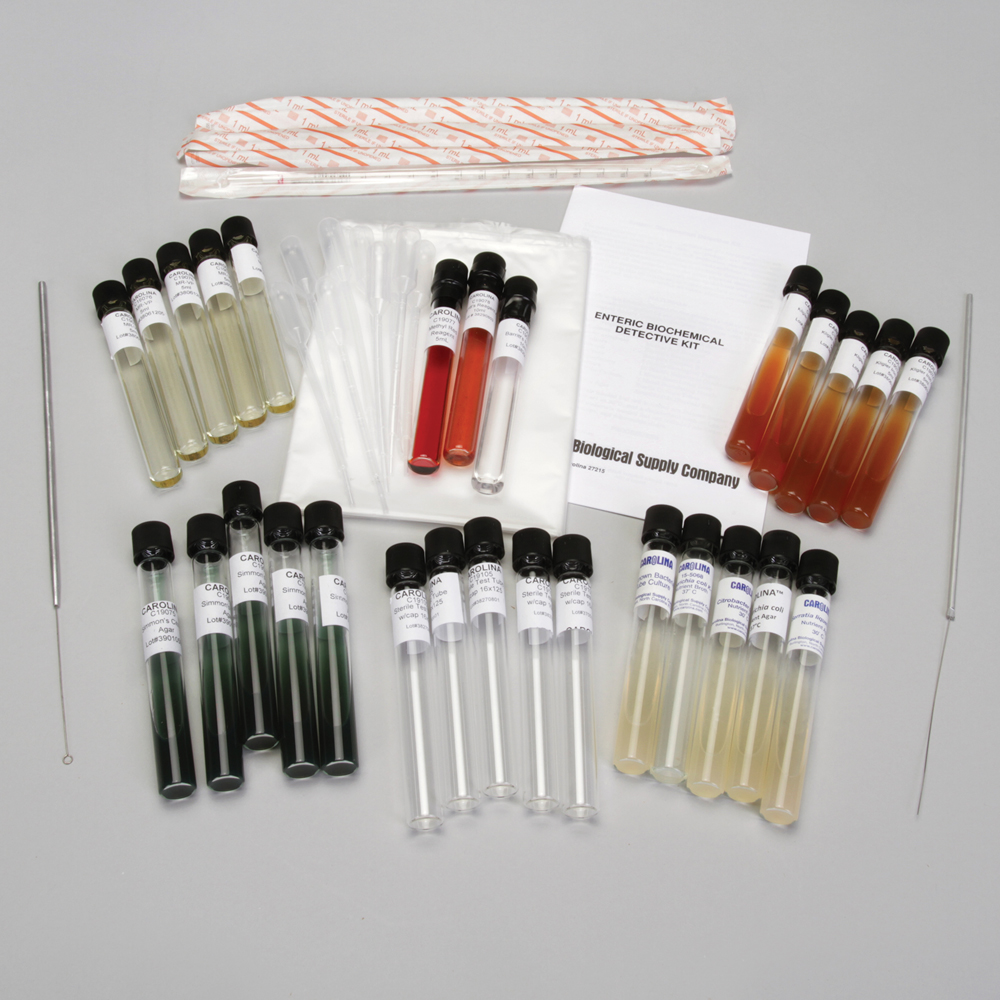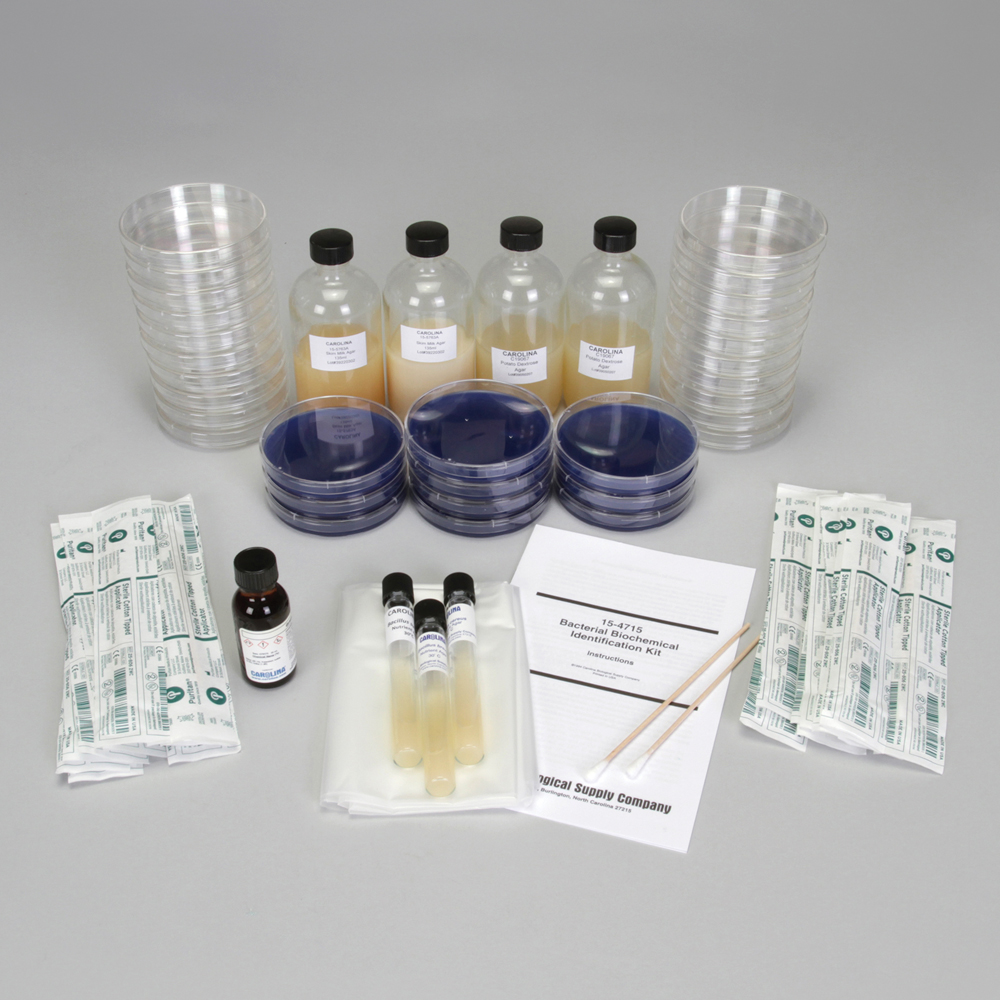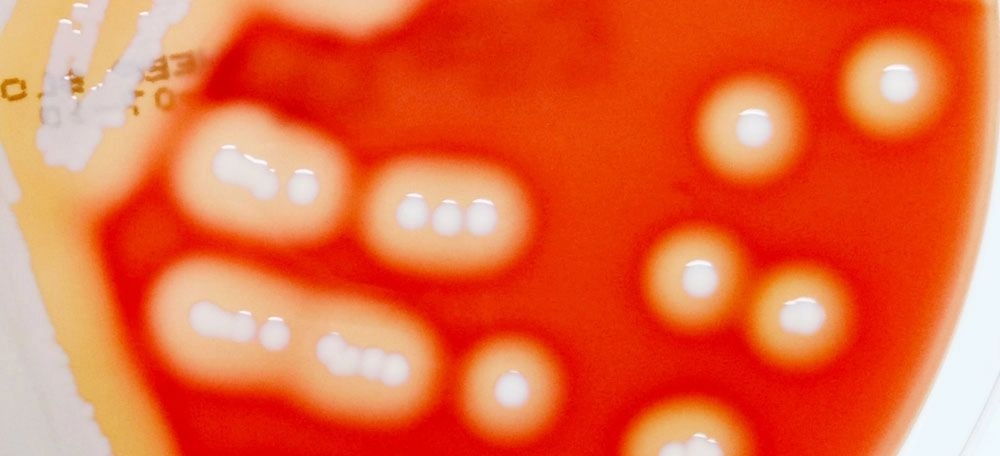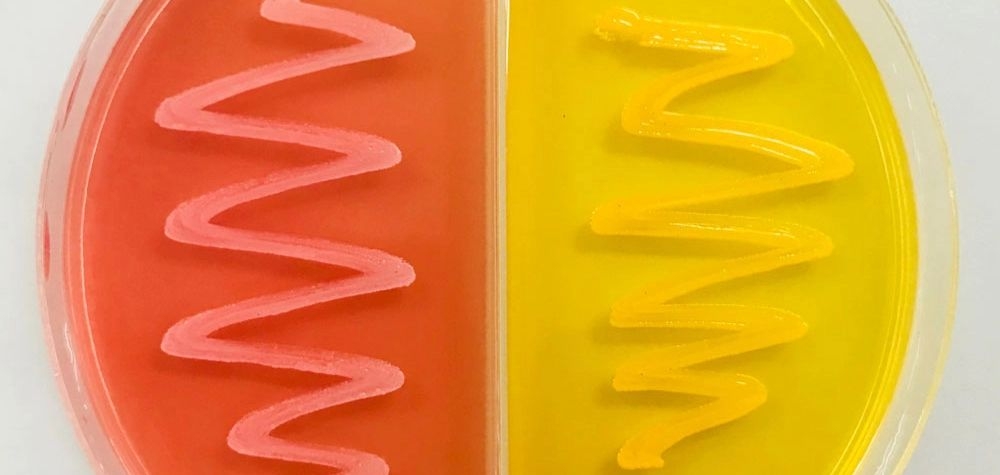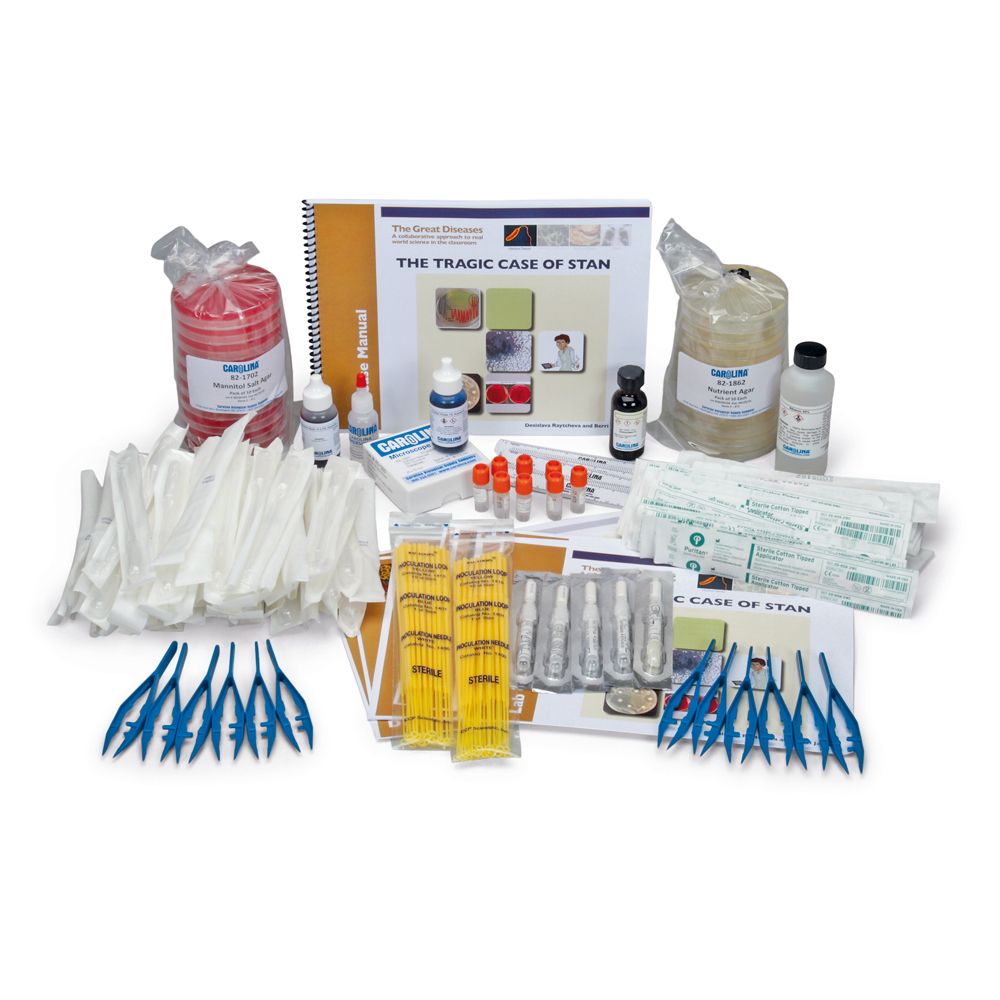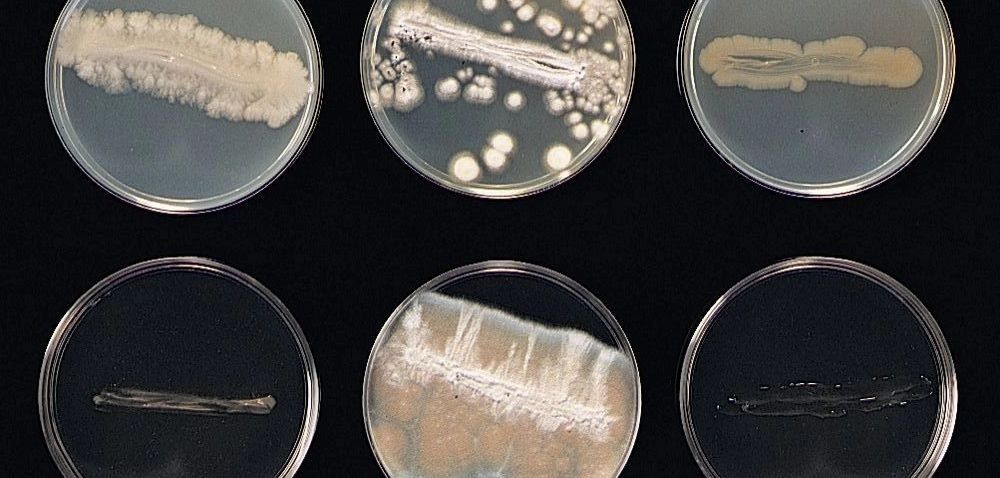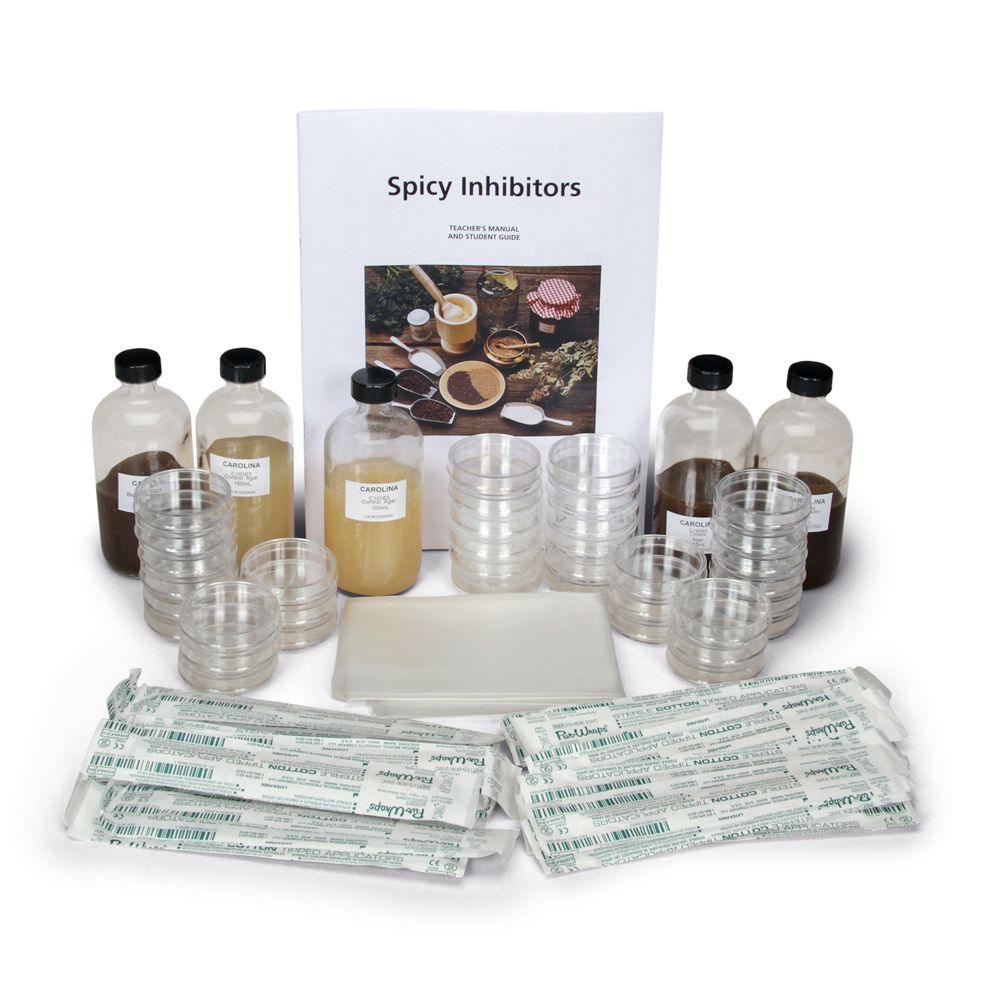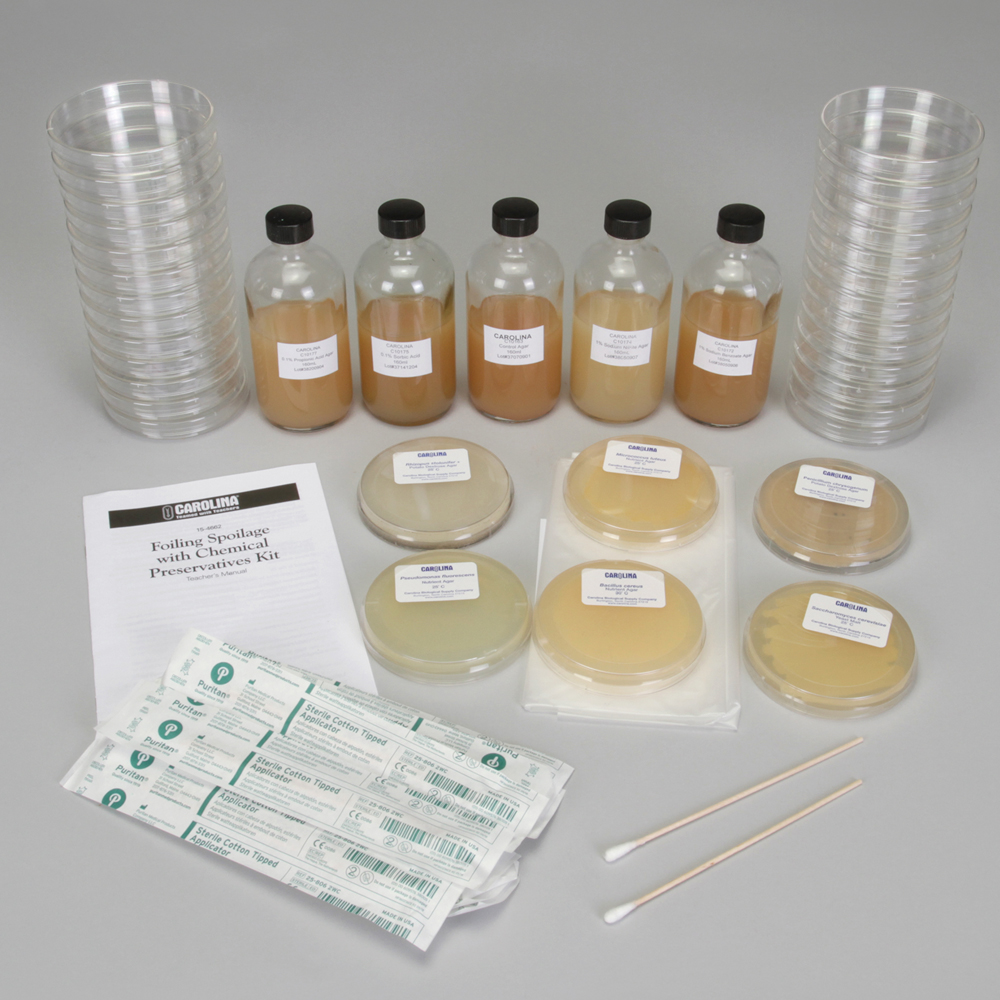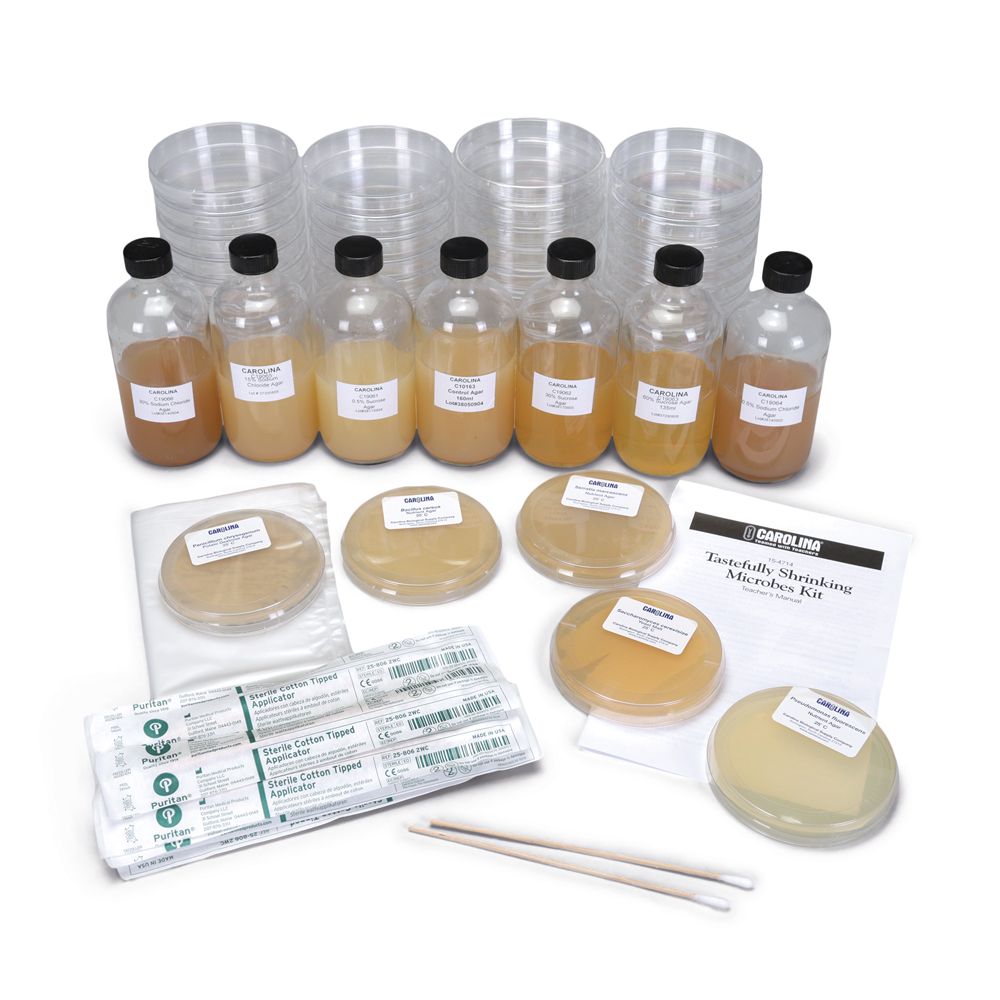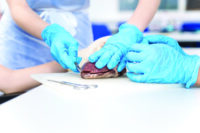Below is a list of popular microbiology labs and some resources that Carolina has available to help support those labs. Procedures for several of these lab activities are available in our free guide Techniques for Studying Bacteria and Fungi. Many of the labs include reusable supplies.
Find our recommendations for the best supplies and equipment for stocking your microbiology lab in our shopping list or view our Microbiology Buying Guide.

Microbiology Buying Guide
Get everything you need to teach your microbiology labs in one place. Carolina is here to provide everything you need to teach your microbiology labs. We have solutions that focus on lab skills and advanced college-level microbiology education. Choose from many relevant topics, including culture growth and identification, antibiotic resistance, and environmental sampling. Want more assistance? Call our customer support team at 800.334.5551 and let our staff and technical experts help you find the products that fit
Basic Microbiology Techniques
Transfer techniques / Aseptic technique
In The Introduction to Sterile Technique lab, students practice transfer of a bacterial culture using sterile technique. The lab is intended as an introductory microbiology activity. Before conducting the lab, ensure that students are familiar with standard lab procedures, including the use of gas burners and personal protective equipment (PPE).
Isolating Bacteria from a Mixture
In the Isolating Bacteria from a Mixture lab, students are introduced to a basic technique used in the study of bacteria: isolating a single species of bacterium from a mixture. In this activity, students practice the technique by using a mixture of bacteria of known composition.
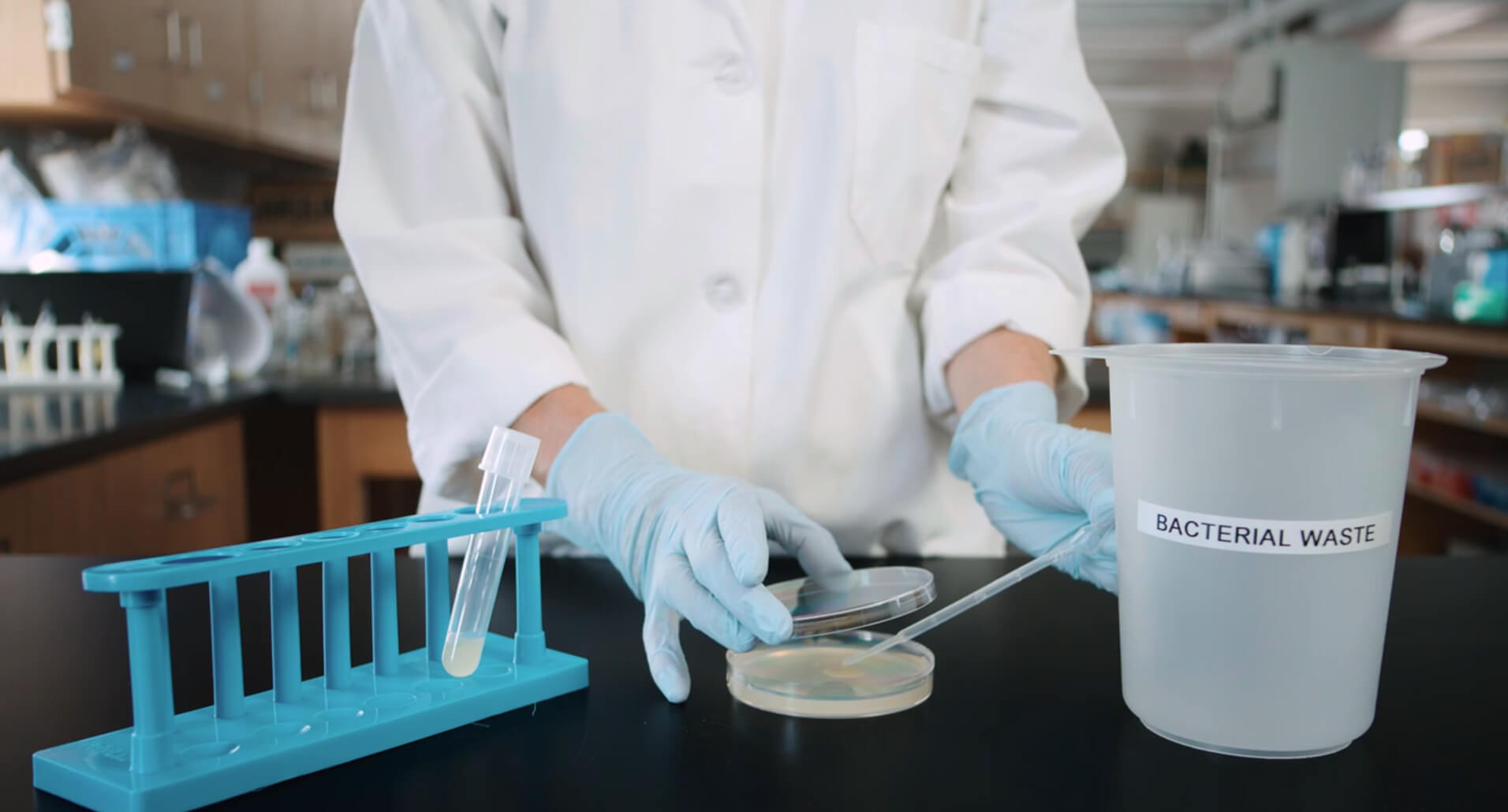
Lab Skills: Aseptic Technique
Aseptic technique is the most fundamental skill for working with microorganisms or biological materials because it prevents contamination of experiments and cultures and reduces the spread of disease.
Bacterial Morphology
Students can view the different cellular morphologies using prepared slides, or they can learn how to prepare bacterial slides, perform simple stains, and observe bacterial cell shapes with the Introductory Bacterial Morphology Set. Either way, they will need a microscope with oil immersion, such as the Wolfe® LED Advanced Binocular Microscope. Use the Characteristics of Bacteria chart if you’d prefer to select your own array of organisms.
Combine environmental sampling with identification of colony characteristics using the Bacterial Investigative BioKit®.
Bacterial Staining
Bacterial Genetics
The ability for bacteria to transfer genes between organisms has been an important factor in the development of several biotechnology tools and in the development of antibiotic resistant bacteria. The Introductory Bacterial Conjugation Kit is useful for teaching bacterial identification and the intercellular transfer of genes for antibiotic resistance between microorganisms. Students identify and confirm the identity of bacteria with different antibiotic resistance by streaking on different antibiotic selective media. Strains are then combined on a “mating” plate to allow conjugation. Results are tested on various media for growth response to demonstrate that DNA can be transferred between 2 genetically different cells.
Biochemical Tests of Bacteria
Biochemical tests can be used to distinguish between similar organisms.
| Sample Bacteria | Motility Test Results | Sulfide Production | Indole Formation |
|---|---|---|---|
| Bacillus cereus | (+) positive | (-) negative | (-) negative |
| Escherichia coli | (+) positive | (-) negative | (-) negative |
| Enterobacter aerogenes | (+) positive | (-) negative | (-) negative |
| Proteus mirabilis | (+) positive | (+) positive | (-) negative |
| Salmonella typhimurium | (+) positive | (+) positive | (-) negative |
| Serratia marcescens | (+) positive | (-) negative | (-) negative |
In the Bacterial Biochemical Identification Kit students conduct starch, lipid, and protein degradation tests on the bacteria to detect the difference between 3 Bacillus species.
Bacterial Motility
Bacterial Motility details how motility in bacteria can be tested for using either the hanging drop method, which requires a depression slide and a microscope, or by stabbing motility media. Motility tests can be combined with other tests such as SIM media which tests for sulfide production and the ability to decompose tryptophan to indole.
Indole Test
In the lab Bacteria: The Indole Test, students perform a differential test to distinguish bacteria based on the production of indole. Bacteria are grown on media containing tryptophan and then treated with Kovac’s reagent. If they possess the enzyme tryptophanase, the bacteria can metabolize tryptophan into indole, pyruvic acid, and ammonia. Kovac’s reagent then reacts with indole to produce a red color that will be concentrated in a layer at the top of the media. In the absence of indole, Kovac’s reagent remains yellow.
Methyl Red/ Voges-Proskauer
Using the MR-VP Test Kit on bacteria grown on MR-VP media, students can test for several metabolic pathways. The Methyl Red (MR) test is positive for organisms that convert dextrose and glucose to pyruvate along a mixed acid pathway, resulting in acidic end products such as lactic, or formic acid. If the organism uses the butylene glycol pathway or another pathway with unstable acidic products, the culture will turn yellow. The VP test detects organisms that produce acetoin via the butylene glycol pathway. A red color is produced in the presence of acetoin and a copper color is produced in its absence.
| Sample Bacteria | MR | VP |
|---|---|---|
| Escherichia coli | (+) positive | (-) negative |
| Enterobacter aerogenes | (-) negative | (+) positive |
| Serratia liquefaciens | (+) positive | (+) positive |
Citrate Test
Bacteria: The Citrate Test outlines how students perform the citrate test. This test determines if organisms can use citric acid as their sole carbon source. The citrate test is often performed as part of the IMViC (Indole, Methyl Red, Voges-Proskauer, and Citrate) series of tests used to differentiate common species of enteric bacteria.
| Sample Bacteria | Citrate Test Results |
|---|---|
| Citrobacter freundii | (+) positive |
| Enterobacter aerogenes | (+) positive |
| Escherichia coli | (-) negative |
| Klebsiella pnemoniae | (-) negative |
Carbohydrate Fermentation Durham Tubes
Phenol Red Broth can be used with a variety of sugars to identify whether organisms can metabolize the sugar substrate. If the organism produces an acid by-product during fermentation the phenol red will turn yellow. If a gas by-product is produced a bubble will form in the immersed Durham tube.
| Sample Bacteria | Dextrose | Lactose | Maltose | Mannitol | Sucrose |
|---|---|---|---|---|---|
| Bacillus cereus | (+) positive | (-) negative | (+) positive | (-) negative | variable |
| Proteus mirabilis | (+) positive | (-) negative | (-) negative | (-) negative | (-) negative |
| Salmonella typhimurium | (+) positive | (-) negative | (+) positive | (+) positive | (-) negative |
| Serratia marcescens | (+) positive | (-) negative | (+) positive | (+) positive | (+) positive |
| Staphylococcus epidermidis | (+) positive | (+) positive | (+) positive | (-) negative | (+) positive |
Blood Agar Test
Blood agars can be used to determine the hemolytic capabilities of a bacteria culture. If the organism can break down hemoglobin completely, they will leave a clear zone surrounding the bacterial growth. Partial breakdown will leave behind a greenish color.
| Sample Bacteria | Hemolysis |
|---|---|
| Streptococcus pneumoniae | alpha hemolysis (incomplete) |
| Streptococcus pyogenes | beta hemolysis (complete) |
| Staphylococcus epidermidis | gamma hemolysis (non-hemolytic) |
Selective and Differential Media
In Bacterial Growth on MacConkey Agar, students culture 3 bacteria on nutrient agar and MacConkey agar and record the results. MacConkey agar is both a selective and a differential media. Crystal violet and bile salts inhibit most Gram-positive bacteria, allowing Gram negative bacteria to grow. The presence of lactose and a pH indicator which differentiates between species that can use lactose and those that cannot. Those that can metabolize lactose produce an acid and change the color of the agar from red to pink.
| Sample Bacteria | Gram -/+ | Lactose Fermentation |
|---|---|---|
| Bacillus subtilis | (+) | No growth |
| Escherichia coli | (-) | (+) positive |
| Pseudomonas fluorescens | (-) | (-) negative |
Like MacConkey agar, mannitol salt agar is both selective and differential. The high salt concentration favors halophiles, while the use of the sugar mannitol as a fermentation substrate will cause the pH indicator Phenol Red to turn the agar yellow in the presence of an organism that can ferment mannitol.
| Sample Bacteria | Mannitol Fermentation |
|---|---|
| Staphylococcus aureus | (+) positive |
| Staphylococcus epidermidis | (-) negative |
Eosin methylene blue agar is selective for Gram-negative bacteria. Depending on the strength of fermentation on sucrose and lactose, the indicators eosin Y and methylene blue will turn the growing colonies purple in moderate to vigorous fermenters. Sometimes a green metallic sheen will form in the presence of vigorous fermenters such as E. coli. Weak fermenters will produce pink colonies. Non-fecal coliform bacteria will be colorless or its normal color.
| Sample Bacteria | Gram -/+ | Lactose Fermentation |
|---|---|---|
| Bacillus subtilis | (+) | No growth |
| Escherichia coli | (-) | (+) positive (strong) |
| Enterobacter aerogenes | (-) | (+) positive (weak) |
| Pseudomonas fluorescens | (-) | (-) negative |
Medical Microbiology
Bring real infectious disease testing into your classroom safely with The Tragic Case of Stan. Created by scientists at the Center for Translational Science Education at Tufts University, this unique kit provides students with a robust learning experience that addresses a real medical problem facing hospitals around the world.
Carolina BioKits®: Antiseptic Versus Disinfectant Sensitivity Kits enable students to discover through experimentation the relative effectiveness of 5 common disinfectants and antiseptics on Escherichia coli, a Gram-negative bacterium, and Bacillus cereus, a Gram-positive bacterium.
Food Microbiology
Humans have managed food spoilage in a wide number of ways. We have food microbiology kits that examine the effects of salt, sugar, spices, and chemical preservatives on microbial growth.
Below is a list of popular microbiology labs and some resources that Carolina has available to help support those labs. Procedures for several of these lab activities are available in our free guide Techniques for Studying Bacteria and Fungi. Many of the labs include reusable supplies.
Find our recommendations for the best supplies and equipment for Stocking your Microbiology lab in our Microbiology Buying Guide.

Microbiology Buying Guide
Get everything you need to teach your microbiology labs in one place. Carolina is here to provide everything you need
Basic Microbiology Techniques
Transfer techniques / Aseptic technique
In The Introduction to Sterile Technique lab, students practice transfer of a bacterial culture using sterile technique. The lab is intended as an introductory microbiology activity. Before conducting the lab, ensure that students are familiar with standard lab procedures, including the use of gas burners and personal protective equipment (PPE).
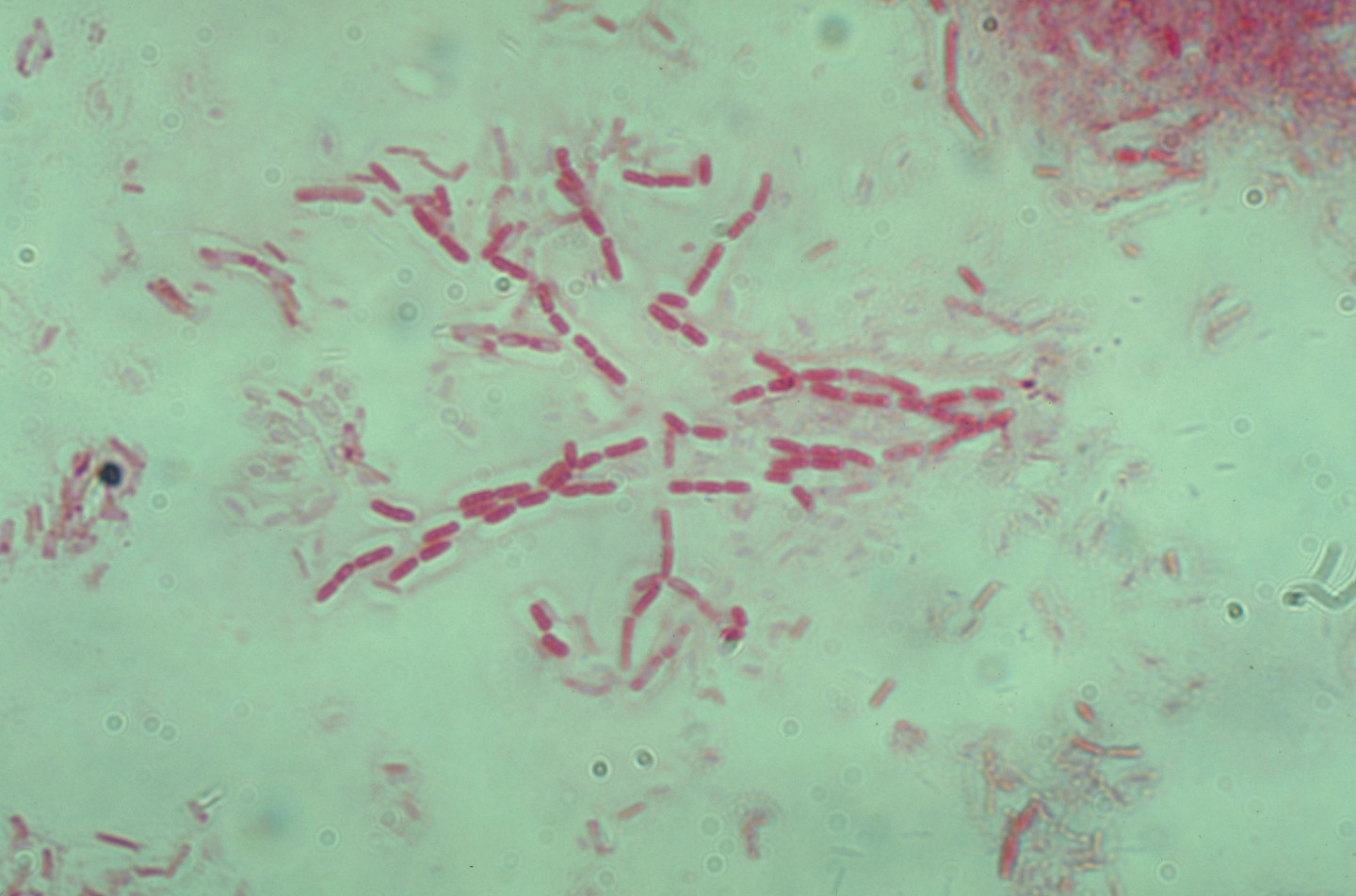
Isolating Bacteria from a Mixture
Carolina Labsheets™ In this lab, students are introduced to a basic technique used in the study of bacteria: isolating a
In the Isolating Bacteria from a Mixture lab, students are introduced to a basic technique used in the study of bacteria: isolating a single species of bacterium from a mixture. In this activity, students practice the technique by using a mixture of bacteria of known composition.
Bacterial Morphology
Students can view the different cellular morphologies using prepared slides, or they can learn how to prepare bacterial slides, perform simple stains, and observe bacterial cell shapes with the Introductory Bacterial Morphology Set. Either way, they will need a microscope with oil immersion, such as the Wolfe® LED Advanced Binocular Microscope. Use the Characteristics of Bacteria chart if you’d prefer to select your own array of organisms.
Combine environmental sampling with identification of colony characteristics using the Bacterial Investigative BioKit®.
Bacterial Staining
Bacterial cells can be colored with a simple stain to provide contrast with the background. Differential stains, which are more complex than simple ones, are used to divide bacteria into groups. Bacteria stain differentially because they differ in cell wall composition. The Gram stain separates almost all bacteria into 2 large groups: Gram-positive bacteria, which stain blue, and Gram-negative bacteria, which stain pink. This classification is basic to bacteriological identification. Endospore stain selectively stains the endospore form of spore-forming bacteria and capsule stain allows visualization of capsules in the bacteria that secrete them.
Bacterial Genetics
The ability for bacteria to transfer genes between organisms has been an important factor in the development of several biotechnology tools and in the development of antibiotic resistant bacteria. The Introductory Bacterial Conjugation Kit is useful for teaching bacterial identification and the intercellular transfer of genes for antibiotic resistance between microorganisms. Students identify and confirm the identity of bacteria with different antibiotic resistance by streaking on different antibiotic selective media. Strains are then combined on a “mating” plate to allow conjugation. Results are tested on various media for growth response to demonstrate that DNA can be transferred between 2 genetically different cells.
Biochemical Tests of Bacteria
Biochemical tests can be used to distinguish between similar organisms.
Carolina’s Enteric Biochemical Detective Kit examines organisms for citrate utilization, hydrogen sulfide production, butanediol fermentation, and mixed acid fermentation.
In the Bacterial Biochemical Identification Kit students conduct starch, lipid, and protein degradation tests on the bacteria to detect the difference between 3 Bacillus species.
Bacterial Motility
Bacterial Motility details how motility in bacteria can be tested for using either the hanging drop method, which requires a depression slide and a microscope, or by stabbing motility media. Motility tests can be combined with other tests such as SIM media which tests for sulfide production and the ability to decompose tryptophan to indole.
| Sample Bacteria | Motility Test Results | Sulfide Production | Indole Formation |
|---|---|---|---|
| Bacillus cereus | (+) positive | (-) negative | (-) negative |
| Escherichia coli | (+) positive | (-) negative | (-) negative |
| Enterobacter aerogenes | (+) positive | (-) negative | (-) negative |
| Proteus mirabilis | (+) positive | (+) positive | (-) negative |
| Salmonella typhimurium | (+) positive | (+) positive | (-) negative |
| Serratia marcescens | (+) positive | (-) negative | (-) negative |
Indole Test
In the lab Bacteria: The Indole Test, students perform a differential test to distinguish bacteria based on the production of indole. Bacteria are grown on media containing tryptophan and then treated with Kovac’s reagent. If they possess the enzyme tryptophanase, the bacteria can metabolize tryptophan into indole, pyruvic acid, and ammonia. Kovac’s reagent then reacts with indole to produce a red color that will be concentrated in a layer at the top of the media. In the absence of indole, Kovac’s reagent remains yellow.
Methyl Red/ Voges-Proskauer
Using the MR-VP Test Kit on bacteria grown on MR-VP media, students can test for several metabolic pathways. The Methyl Red (MR) test is positive for organisms that convert dextrose and glucose to pyruvate along a mixed acid pathway, resulting in acidic end products such as lactic, or formic acid. If the organism uses the butylene glycol pathway or another pathway with unstable acidic products, the culture will turn yellow. The VP test detects organisms that produce acetoin via the butylene glycol pathway. A red color is produced in the presence of acetoin and a copper color is produced in its absence.
| Sample Bacteria | MR | VP |
|---|---|---|
| Escherichia coli | (+) positive | (-) negative |
| Enterobacter aerogenes | (-) negative | (+) positive |
| Serratia liquefaciens | (+) positive | (+) positive |
Citrate Test
Bacteria: The Citrate Test outlines how students perform the citrate test. This test determines if organisms can use citric acid as their sole carbon source. The citrate test is often performed as part of the IMViC (Indole, Methyl Red, Voges-Proskauer, and Citrate) series of tests used to differentiate common species of enteric bacteria.
| Sample Bacteria | Citrate Test Results |
|---|---|
| Citrobacter freundii | (+) positive |
| Enterobacter aerogenes | (+) positive |
| Escherichia coli | (-) negative |
| Klebsiella pnemoniae | (-) negative |
Carbohydrate Fermentation Durham Tubes
Phenol Red Broth can be used with a variety of sugars to identify whether organisms can metabolize the sugar substrate. If the organism produces an acid by-product during fermentation the phenol red will turn yellow. If a gas by-product is produced a bubble will form in the immersed Durham tube.
| Sample Bacteria | Dextrose | Lactose | Maltose | Mannitol | Sucrose |
|---|---|---|---|---|---|
| Bacillus cereus | (+) positive | (-) negative | (+) positive | (-) negative | variable |
| Proteus mirabilis | (+) positive | (-) negative | (-) negative | (-) negative | (-) negative |
| Salmonella typhimurium | (+) positive | (-) negative | (+) positive | (+) positive | (-) negative |
| Serratia marcescens | (+) positive | (-) negative | (+) positive | (+) positive | (+) positive |
| Staphylococcus epidermidis | (+) positive | (+) positive | (+) positive | (-) negative | (+) positive |
Blood Agar Test
Blood agars can be used to determine the hemolytic capabilities of a bacteria culture. If the organism can break down hemoglobin completely, they will leave a clear zone surrounding the bacterial growth. Partial breakdown will leave behind a greenish color.
| Sample Bacteria | Hemolysis |
|---|---|
| Streptococcus pneumoniae | alpha hemolysis (incomplete) |
| Streptococcus pyogenes | beta hemolysis (complete) |
| Staphylococcus epidermidis | gamma hemolysis (non-hemolytic) |
Selective and Differential Media
In Bacterial Growth on MacConkey Agar, students culture 3 bacteria on nutrient agar and MacConkey agar and record the results. MacConkey agar is both a selective and a differential media. Crystal violet and bile salts inhibit most Gram-positive bacteria, allowing Gram negative bacteria to grow. The presence of lactose and a pH indicator which differentiates between species that can use lactose and those that cannot. Those that can metabolize lactose produce an acid and change the color of the agar from red to pink.
| Sample Bacteria | Gram -/+ | Lactose Fermentation |
|---|---|---|
| Bacillus subtilis | (+) | No growth |
| Escherichia coli | (-) | (+) positive |
| Pseudomonas fluorescens | (-) | (-) negative |
Like MacConkey agar, mannitol salt agar is both selective and differential. The high salt concentration favors halophiles, while the use of the sugar mannitol as a fermentation substrate will cause the pH indicator Phenol Red to turn the agar yellow in the presence of an organism that can ferment mannitol.
| Sample Bacteria | Mannitol Fermentation |
|---|---|
| Staphylococcus aureus | (+) positive |
| Staphylococcus epidermidis | (-) negative |
Eosin methylene blue agar is selective for Gram-negative bacteria. Depending on the strength of fermentation on sucrose and lactose, the indicators eosin Y and methylene blue will turn the growing colonies purple in moderate to vigorous fermenters. Sometimes a green metallic sheen will form in the presence of vigorous fermenters such as E. coli. Weak fermenters will produce pink colonies. Non-fecal coliform bacteria will be colorless or its normal color.
| Sample Bacteria | Gram -/+ | Lactose Fermentation |
|---|---|---|
| Bacillus subtilis | (+) | No growth |
| Escherichia coli | (-) | (+) positive (strong) |
| Enterobacter aerogenes | (-) | (+) positive (weak) |
| Pseudomonas fluorescens | (-) | (-) negative |
Medical Microbiology
Bring real infectious disease testing into your classroom safely with The Tragic Case of Stan. Created by scientists at the Center for Translational Science Education at Tufts University, this unique kit provides students with a robust learning experience that addresses a real medical problem facing hospitals around the world.
Carolina BioKits®: Antiseptic Versus Disinfectant Sensitivity Kits enable students to discover through experimentation the relative effectiveness of 5 common disinfectants and antiseptics on Escherichia coli, a Gram-negative bacterium, and Bacillus cereus, a Gram-positive bacterium.
Food Microbiology
Humans have managed food spoilage in a wide number of ways. We have food microbiology kits that examine the effects of salt, sugar, spices, and chemical preservatives on microbial growth.


